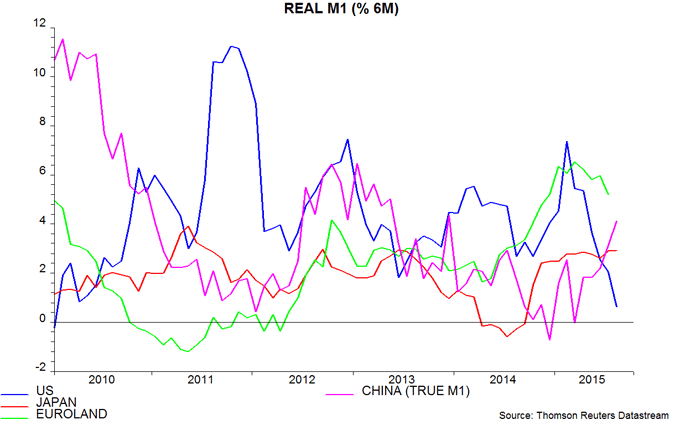Is the consensus wrong about US / Chinese economic prospects?
Economists expect stronger US growth next year but a further slowdown in China. The average forecast for US GDP growth in 2016 is 2.7%, up from 2.3% in 2015, according to Consensus Economics. Chinese GDP expansion, meanwhile, is projected to fall from 6.9% to 6.7%. Given a widespread belief that GDP data are manipulated, the consensus probably expects a larger decline in actual Chinese growth.
Narrow money trends, however, are giving an opposite message for economic prospects. Six-month growth of US real (i.e. consumer price-deflated) M1 fell to 0.6%, or 1.3% at an annualised rate, in August, the lowest since January 2010. Chinese real “true” M1* growth, by contrast, rose to 4.1%, or 8.3% annualised, a 20-month high – see chart.
Narrow money signals have provided valuable insights in both countries in recent years. US six-month real M1 growth fell in summer 2014 ahead of an economic “soft patch” in early 2015. It rebounded strongly around end-2014, predicting faster economic expansion over the summer / autumn: GDP rose by 3.7% annualised in the second quarter. Chinese real true M1, meanwhile, contracted during the second half of 2014, forewarning of recent economic weakness.
Narrow money is a leading indicator because the demand to hold it is influenced importantly by spending intentions. The US M1 slowdown suggests that households and firms have turned more cautious and are scaling back their plans, possibly temporarily, ahead of expected Fed policy tightening. The Chinese pick-up, by contrast, is evidence that monetary and fiscal policy easing is gaining traction by lifting confidence and spending intentions.
Chinese M1 strength contradicts claims that domestic liquidity would contract as a result of foreign exchange intervention to support the currency (“quantitative tightening”). Such claims amount to treating Chinese monetary arrangements as a pure currency board, ignoring the panoply of tools available to the authorities to offset intervention effects on the monetary base and money holdings of households and firms.
If the message of current narrow money trends is correct, US GDP growth will, once again, fall short of the consensus forecast in 2016, suggesting limited pressure for Fed rate hikes. A rebound in China, meanwhile, should support global economic expansion. Such a combination could imply a favourable backdrop for markets. Additional US M1 weakness, however, or a relapse in China, would be concerning.
*True M1 = official M1 plus household demand deposits. Official M1 = cash in circulation plus demand deposits of corporations and government organisations. Annual true M1 growth rose to 8.9% in August from a low of 2.0% in March.


Reader Comments